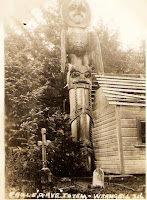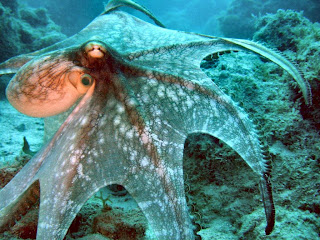A Ruffle of Feathers
 Of all the birds
in Southeast Alaska, Raven is the most predominant, and certainly, the most
interesting. In the Tlingit nation, moieties are grouped as birds: Raven and
Eagle/Wolf. Raven (Corvus corax) is a member of the crow family; ravens are
much larger, about two-feet-tall with a wingspan of four feet. Ravens are
voracious scavengers, a theme reflected in many of the Tlingit oral traditions
about Raven in search of food.
Of all the birds
in Southeast Alaska, Raven is the most predominant, and certainly, the most
interesting. In the Tlingit nation, moieties are grouped as birds: Raven and
Eagle/Wolf. Raven (Corvus corax) is a member of the crow family; ravens are
much larger, about two-feet-tall with a wingspan of four feet. Ravens are
voracious scavengers, a theme reflected in many of the Tlingit oral traditions
about Raven in search of food.In Suomi, Raven is Korppi; in Sapmi, Garangjas; In Tlingit aaní, Yéil. Raven is found in many cultures throughout the world. In Norse mythology there are twin ravens: Hugin and Munin (thought and memory). Although Raven sometimes makes mistakes, he is a creator, a storyteller, and a teacher. Raven makes mistakes so we don’t have to; through Raven’s adventures, we learn how to behave. Foremost, Raven is a trickster.
In nearly every culture where Ravens roost, one will discover stories about this mysterious bird. Tlingit oral tradition says Raven was originally white but when he stole water from Petrel—Ganuk, he flew up through the smokehole and became black from soot. Raven is the great shape-shifter, the great imitator; imitating animal sounds, cat cries and baby wails, and human speech.
*
My friend, Owen, is
a trickster too. He is belongs to the Kiks.adí, a Raven clan. He sits on the
beach at Glacier Bay—Sít Eeti Geeyí calling to a loon and the loon answers back. He
shows a group of children how he can mimic the birds, seals, and nearly any
animal in Southeast Alaska. The children have come over on a boat from Hoonah
to visit their ancestral homeland, Glacier Bay.
I am one of a few teachers assigned to teach the Tlingit language while
on this trip. Owen calls to the loon and a loon answers back. He calls to the Eagle and then to the Raven. His deadpan bird imitations come from spending his whole life out-of-doors. Owen is a hunter, fisherman, a traditional dancer, a carver and a trickster. He tricks Raven and Raven caws back. The raven comes circling above us and lands on a tree nearby—this time, Raven is fooled.
Myself, I never shoo Ravens. They are now my relatives. My oldest daughter's Tlingit name is Yéilk', "Cute-Little-Raven," and mine is Yéilk' Tlaa, "Mother-of-Cute-Little-Raven." I listen for a while as Owen tries to get the children to mimic the raven's sounds. He lifts his head slightly and opens his throat, and a chortle emerges. The raven in the tree answers. The children giggle. They all try it, but the cacophony makes the bird fly away. After a few minutes, I turn and discover that the raven has landed about fifty feet beyond me. They are curious birds. I reach into my pocket and take out a granola bar and unwrap it. I break it into pieces and walk towards the bird. He flies into the trees. I put the pieces of the granola bar on log near the treeline, far enough from the children who are now practicing their loon calls.
I head back near the children but keep an eye on the log. Sure enough, Raven flies down and hops cautiously along. He grabs the pieces and eats them. I figure that since Raven was likely a bit confused about being called by my friend Owen that I owed the bird a snack; an offering of sorts. Raven is, after all, a relative, a clan member, and a fellow storyteller. I watch him for a while as he watches us, possibly hoping for another scrap of food. Maybe, though, he enjoys listening to the children, their hoarse barks calling seals. Maybe, he'll fly off to the roost and as darkness settles, he'll tell of those odd humans who sat in the rain on the beach in Glacier Bay one day, shape-shifting in an out of themselves; tucking their heads down, their throat feathers ruffled, cawing into the gray mist.
*First appeared in Alaska Women Speak
NOTE:
Dear Readers, Planet Alaska will be hosting a >Language> Place blog carnival in August.
The theme is INSPIRATION. Here are the details:
| Call #17: Inspiration | |
|
Edition
#17 will be hosted by lifelong Alaskan Vivian Faith Prescott, who writes
poetry & prose about the human relationship to the landscape. The feature
theme is “Inspiration.” Contributions are invited from writers,
artists, photographers, poets, & bloggers, or anyone who is inspired. Please
interpret widely & wildly. Guidelines (Deadline is end of July) The feature theme for Edition #17 is “Inspiration.” Contributions are invited from writers, artists, photographers, poets, & bloggers, or anyone who is inspired. Please interpret widely & wildly. Inspiration, language & place: In my Sáami culture, places and landscapes can communicate without words: They have their own language. I know of a rock on a certain beach that tells a story. It has been there for thousands of years watching bears traverse the beach. If I sit on the rock, sure enough, I'm inspired to write something. What place inspires you? What does it say? How do you listen there? There is a story behind the volcano I see out my window every day. Places can even have their own songs (a yoik). Places speak to us. They inspire writing, thoughts, art, a personal change, & more. You return to that place over and over again because you know it has a language of its own and that the place will ‘say' something to you. It inspires you. Please interpret widely & wildly. Submissions are open until end of July *** | |




Comments